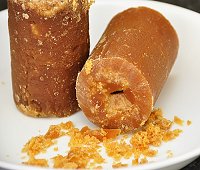 |
Palm Sugar or Coconut Sugar (Naam
dtaan bpuk)
This type of sugar has a rich caramel flavor quite different
from cane sugar and is used to make authentic Thai kanom
(sweets). It is also added to Thai stir-fries and dipping
sauces and should be used in recipes calling for palm or
coconut sugar. Palm sugar is made from the sap of the
coconut palm flower and is the most used type of sugar in
traditional Thai cooking.Palm Sugar is sugar made from
boiling the sap from the fruit of the palm tree. There are
two types of ‘Palm Sugar’ — sugar which comes from Coconut,
and sugar which comes from Sugar Palm. Either can be used. |
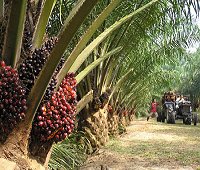 |
Palm Oil (Nahm meun peut)
This inexpensive cooking oil is used daily for frying and
flavoring in soups in Thailand. Many farmers grow palm trees
(see left) for oil production in Thailand and Malaysia.
Substitute a light oil like canola, sunflower or peanut oil
if unavailable. |
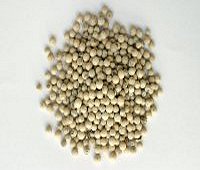 |
Peppercorns (Prik thai)
White, black, and green peppercorns all come from
the same tropical vine. Young green peppercorns are used in
curries, stir fry, and 'nam prik'. White Pepper is used the
most commonly in Thai cooking. |
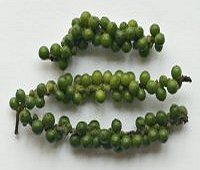 |
Fresh Peppercorns (Prik
Thai Onn)
Whole fresh peppercorns still on the
stem are thrown into some dishes,
notably ‘Phad Kee Mao’ and ‘Gaeng
Paa’. Storage: Store fresh
peppercorns sealed in the
refrigerator. They should last a few
weeks or so.
|
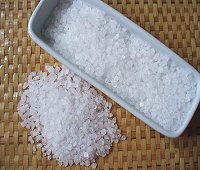 |
Sea Salt (Gluah)
Used for all cooking (not just Thai-ask a French
chef!), sea salt is far superior in taste to mined salt. It
aides in the grinding of dry ingredients in the mortar and
pestle when making Thai curries. |
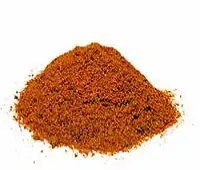 |
Chili Powder (Prik bpon)
Chili Powder is made from dried and ground small chilies.
It’s used to flavor and add spice mainly to soups and
noodles. |
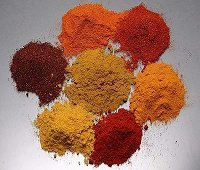 |
Curry Powder (Pong Ga-ree)
Curry Powder is a ground up blend of spices. It’s orange
from tumeric. It’s more popular in Southern Thai cooking. |
|
|
White Sugar (Naam dtaan
saay khaaw)
White sugar is used in a lot of dishes. Use
regular white cane sugar |
|
|
Cinnamon Sticks (Ope
cheuy)
Cinnamon Sticks are used whole in some
Chinese-Thai dishes, such as Five Spice Tofu. It is also
sometimes put into Massaman Curry. However, Cinnamon is
never used in sweets like it is in the West! |
|
|
Cassia Leaves (Bai Gra
wan)
Cassia Leaves are very similar in appearance to
Bay Leaves. These are dried leaves from the cassia tree, a
type of cinnamon. They are primarily used in Massaman Curry.
Commonly in Asian markets they are labeled “Indian Bay
Leaves”. |
|
|
Cardamom (Look Gra wan)
Cardamom seeds are used in Chinese, South East
Asian and Indian cooking. They’re also used in some Western
Desserts and Indian spiced tea (masala chai). A few roasted
pods make a great addition to Massaman Curry. There are
generally two types of cardamom, a green and very fragrant
variety from India, and this brown fatter variety from
China. Thais usually use the brown one. |
|
|
Fish Sauce (Naam pla)
Fish sauce is made from anchovies (or any small
fish), water, and salt and left to ferment for up to a year.
Fish sauce is one of the oldest ingredients in the world. |
|
|
Light Soy Sauce (See yew kao)
Light or White soy sauce is not as dark or thick
as Dark Soy Sauce. Do not use Chinese or Japanese soy
sauce for Thai recipes as the flavour is different. |
|
|
Dark Soy Sauce (See yew dam)
Black soy sauce is thick and black,
and has a different flavor than
white soy sauce. It’s mainly used in
Chinese-Thai cooking, marinades,
etc.
|
|
|
Sweet Soy Sauce (See yew dam wahn)
Sweet soy sauce is a bit darker and
thicker than black soy sauce. It’s
sweet, with a hint of molasses.
|
|
|
Oyster Sauce (Naam man hoy)
Oyster Sauce is used in a few Chinese-Thai
dishes. It is made from oysters. |
|
|
Tamarind Paste (Naam makam)
Tamarind is a very sour fruit which comes from a
tall tree. The fruit is then squeezed with hot water, and
the seeds removed to create this paste. |
|
|
Coconut Milk (Guh tea) and Coconut
Cream
Coconut Milk & Cream are essentially the same
thing. The cream is thick and will rise to the top, similar
to un-homogenized milk. It also has more fat than the milk.
Homemade coconut milk/cream has the best flavor. A good
substitute is canned coconut milk from Thailand. Good brands
are: Chao Koh (Island People) and Mae Ploy. If you buy
canned it’s best not to shake the can like they suggest.
Instead, open it and use the ‘head’ (cream) to fry the curry
paste in. The coconut fat really brings out the flavor!
There are bags of frozen coconut milk available in some
Asian groceries. While the flavor is better than canned, it
separates and gets chunky when you heat it. |
|
|
White Vinegar (Naam som saay choo)
Thais use the regular clear white vinegar |
|
|
Vegetable Oil (Naam mun poot)
Vegetable oil is used in almost all Thai food
which is cooked on the stove. Any oil will work, Rice
Oil and Peanut Oil or Soy oil. Most Thais use Palm Oil. |
|
|
Chicken Dipping Sauce or Thai Sweet
Chili Sauce (Naam jim gai)
Sweet and tangy. This sauce is used
to dip fried chicken. It can also be
used for a dipping sauce for fried
spring rolls, or any fried ’street
food’. Store opened bottles in the
fridge.
|
|
|
Salted Bean Paste (Dtao jee oh)
This sauce is made from soy beans which are
fermented with salt. In my opinion, dishes like ‘Raad Naa’,
and ‘Pak Boong Fai Daeng‘ would not be tasty without salted
bean paste. |
|
|
Curry Paste (Kruang gaeng)
Curry Paste comes in so many varieties. The most
common is ‘Red Curry Paste’, which is pictured to the left.
You can make your own, or you can buy pre-made at most Asian
groceries |
|
|
Shrimp Paste (Guh bee)
Shrimp paste is a fairly common
ingredient in Thai cooking. It’s
made from dried small shrimp, left
to ferment and solidify, and then
cut into cubes or sold in jars.
Shrimp paste is in almost all curry
pastes, some naam prik, stir fries,
and there’s even a rice dish which
is cooked in it.
|
|
|
Stock, Bullion Cubes, Stock powder (Kha
nore)
Bullion/Soup stock cubes are
essentially a fast trick to replace
chicken or pork broth in a soup or
curry. Knorr brand makes some which
are available in Thailand as well as
Asian food stores in the West which
have flavor more suitable to Thai
food. There are even ‘tom yum’
flavors! The ’shitake mushroom’
flavor works well for a vegetarian
substitute for chicken or pork
broth. These cubes are very
flavorful, so only 1/4 or 1/2 cube
is enough for a soup. They’re also
very salty, so be careful.
|